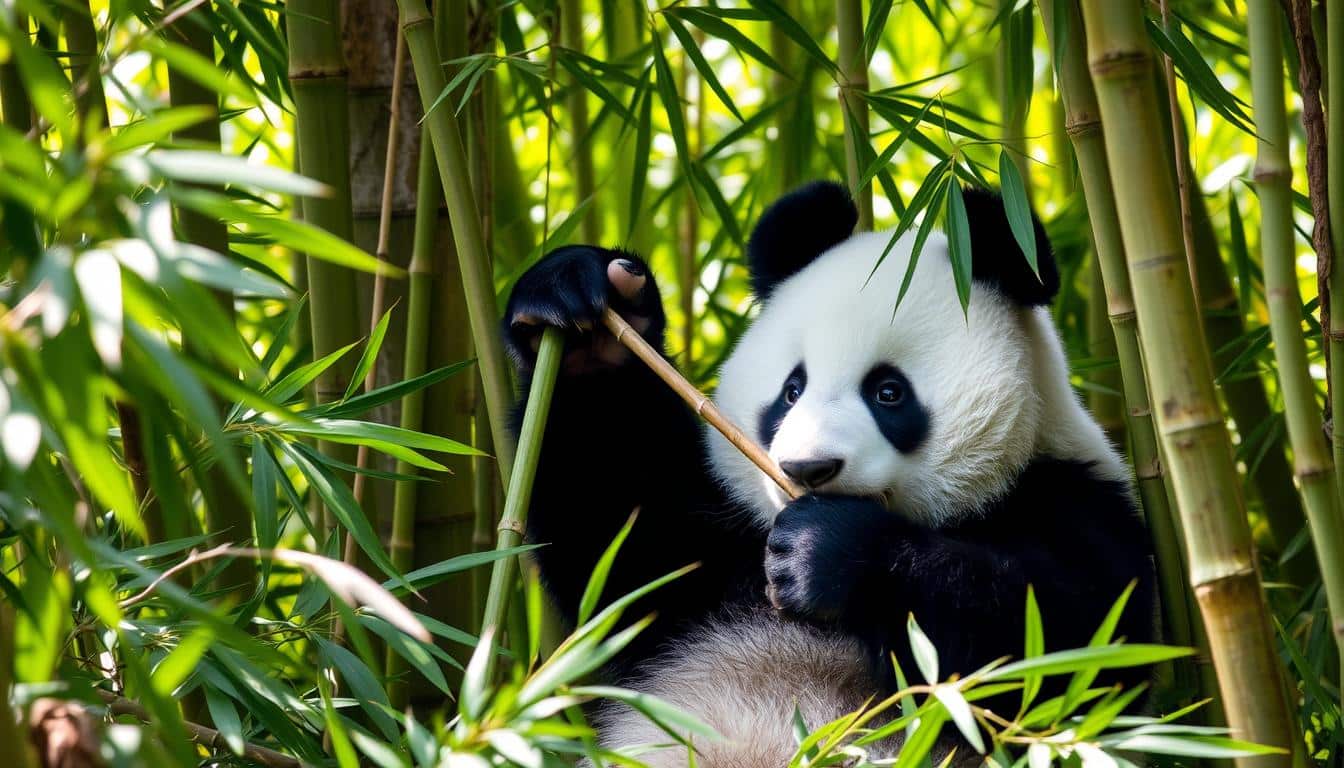The giant panda, known as Ailuropoda melanoleuca, is a unique creature. Panda Bamboo Diet It’s a carnivore but eats mostly bamboo. They spend up to 14 hours a day eating this plant. Bamboo is nearly 99% of their diet, giving them the nutrients and energy they need.
Pandas rely heavily on bamboo, showing their amazing adaptability. They have special jaws and teeth for eating bamboo. Unlike other herbivores, pandas get 50% of their energy from protein, like carnivores.
The panda’s diet challenges old ideas about herbivores and carnivores. Their gut works like a carnivore’s, helping them digest protein well. This lets them live on bamboo, even though it’s not very nutritious.
Key Takeaways
- Giant pandas spend 12 to 14 hours a day consuming bamboo, which makes up almost their entire diet.
- Pandas extract about 50% of their energy from protein, similar to cats or wolves, while other herbivorous mammals typically get only 20% of their energy from protein.
- Bamboo shoots preferred by pandas can contain up to 32% protein, compared to only 19% in bamboo leaves.
- Pandas have a carnivore-like gut that helps them process protein effectively from their bamboo-based diet.
- The nutritional composition of the panda’s diet challenges traditional herbivore and carnivore classifications.
Introduction to the Panda Bamboo Diet
Giant pandas are known for eating mostly bamboo. They spend up to 12-14 hours a day eating this plant. Even though they belong to the Carnivora order, pandas have become specialized herbivores, mainly eating bamboo.
Pandas’ Unique Dietary Adaptation
The panda’s diet is a remarkable story of evolution. Despite being in the Carnivora order, pandas have evolved special jaws and teeth for bamboo. They also have a “pseudo-thumb” for easier plant manipulation. Interestingly, pandas can’t taste meat, showing they are true herbivores.
Importance of Bamboo in a Panda’s Diet
Bamboo is vital for pandas’ survival. They eat about 12 kilograms of bamboo daily. But, they can only digest 17% of it, showing their unique digestive system.
This shows their deep connection to bamboo, a diet they’ve followed for at least three million years. Their fossilized teeth confirm this.
Despite being classified as Carnivora, pandas have adapted to be herbivores. Bamboo is the key to their diet. Their unique features and history have made them dependent on bamboo for survival.
Nutritional Composition of Bamboo

Bamboo is the main food for giant pandas. These animals have special ways to get nutrients from bamboo. Even though bamboo seems simple, pandas can make the most of it.
Protein Content in Bamboo Shoots and Leaves
For eight months, pandas eat a certain bamboo type. They focus on the shoots, which are full of protein. These shoots have up to 32% protein, more than the 19% in bamboo leaves.
In summer, pandas move to higher places. There, they find another bamboo type with lots of protein. This keeps their diet balanced all year.
Carbohydrate and Fat Content in Bamboo
Pandas are good at getting protein from bamboo. But they don’t take much of the carbs and fats. This makes their diet mostly protein, like carnivores.
Most plant-eating animals get only 20% of their energy from protein. But pandas get about 50% from protein.
| Nutrient Composition | Bamboo Shoots | Bamboo Leaves |
|---|---|---|
| Protein | 32% | 19% |
| Carbohydrates | Low | Moderate |
| Fats | Low | Low |
The table shows how bamboo shoots and leaves differ in nutrients. It shows why pandas are picky about what they eat. This helps them get the most from bamboo.
Panda Bamboo Diet: Nutritional Requirements
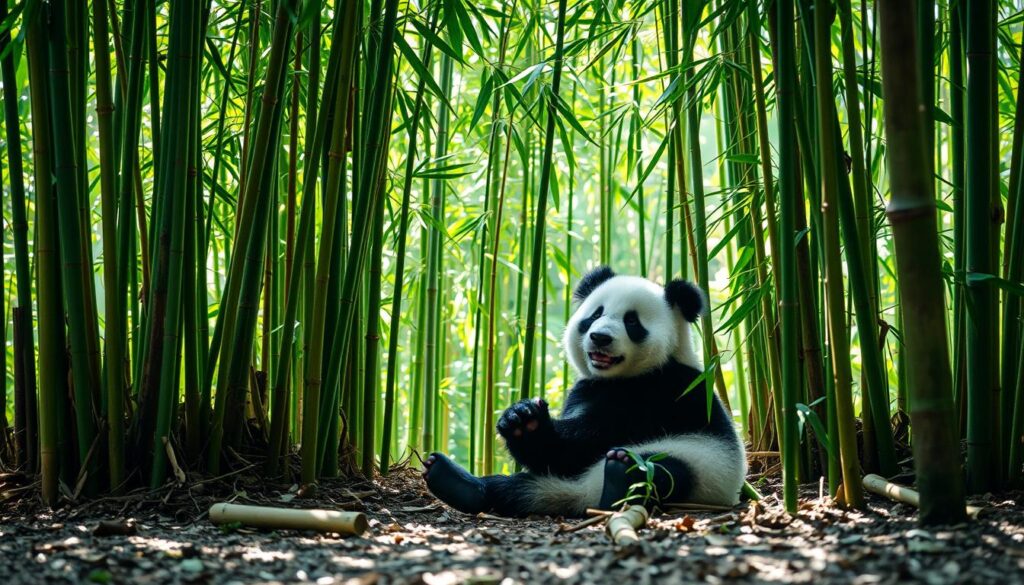
Giant pandas have a diet mostly based on bamboo. But, they have special nutritional needs that set them apart from other herbivores. Their diet is surprisingly rich in protein, making up about 50% of their energy intake. This is similar to carnivores like cats or wolves.
This shows that pandas have learned to get the most nutrients from bamboo. They use protein as their main energy source. Bamboo shoots have about 32% protein, and bamboo leaves have 19%. These parts of the bamboo plant are key for the panda’s diet.
Wild pandas eat a lot of bamboo, leaving up to 120 droppings a day. This shows how much they rely on bamboo. Studies of these droppings show that pandas get more protein than carbohydrates or fat from their diet.
This unique way of eating helps giant pandas to do well on their bamboo-based diet. They focus on protein-rich parts of the bamboo. This way, they keep their diet balanced and meet their special needs.
Pandas’ Digestive System and Gut Microbiota
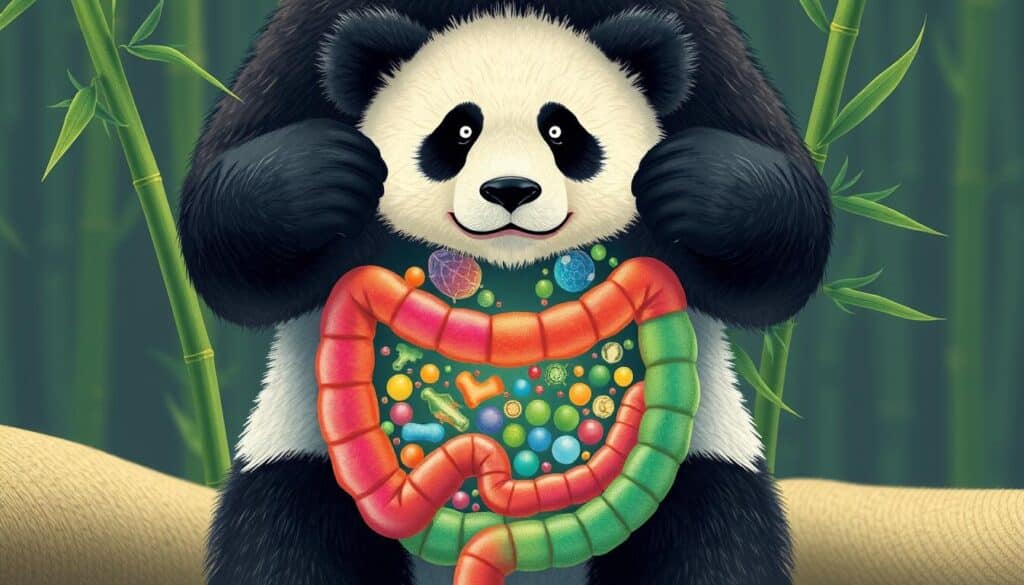
Giant pandas are part of the bear family but eat almost all bamboo. They have a digestive system like a carnivore’s. Yet, they can break down bamboo’s tough cellulose thanks to their gut microbes.
Carnivore-like Digestive System in Pandas
Despite eating mostly bamboo, pandas have a carnivore-like gut. This helps them get nutrients from their bamboo diet. Their gut microbes are key in breaking down bamboo’s complex carbs.
Role of Gut Microbiota in Bamboo Digestion
Research shows pandas’ gut microbes change when they eat bamboo. This is like other carnivores switching to plants. Their gut is good at getting nutrients from bamboo, which is almost all their diet.
| Statistic | Significance |
|---|---|
| The gut microbiota diversity of eight panda cubs significantly decreased after bamboo consumption. | Indicates that the panda’s gut microbiome adapts to its predominantly bamboo-based diet. |
| Carnivorous species living on a plant-based diet possess low microbial diversity. | Suggests that pandas, as carnivores adapted to a bamboo diet, would also have lower gut microbiota diversity. |
| Giant pandas have a gut microbiota more similar to carnivores than herbivores in terms of bacterial composition and functional potential. | Highlights the unique digestive adaptation of pandas to their bamboo-based diet. |
The panda’s gut microbiome is vital for breaking down bamboo’s carbs. This lets them get the nutrients they need from bamboo.
Panda Bamboo Diet
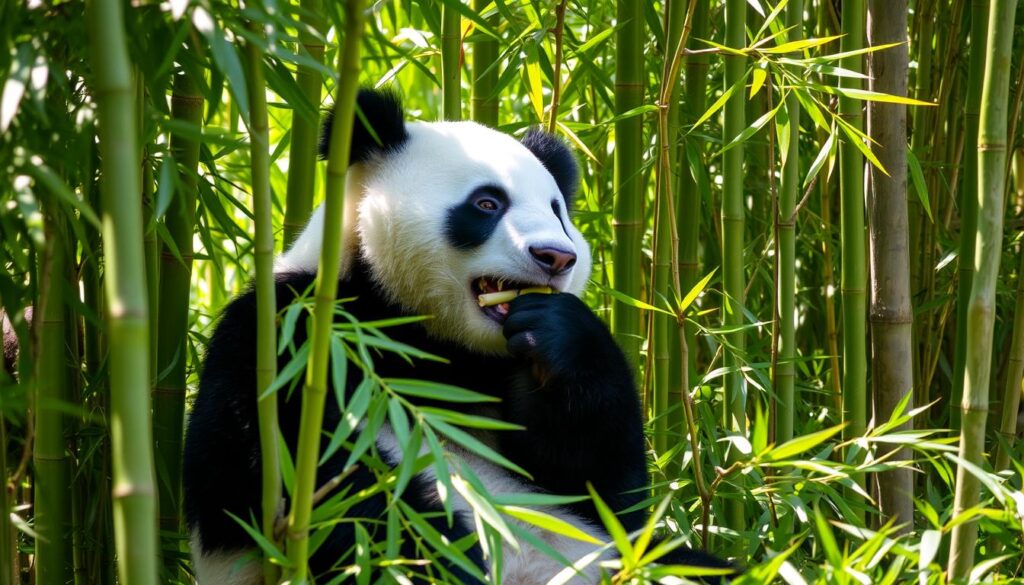
Giant pandas are famous for eating almost only bamboo. These black-and-white bears have learned to live mainly on this grass-like plant. It shows how well they can adapt and survive.
Bamboo Species Consumed by Pandas
Pandas mainly eat two bamboo types. For 8 months, they eat the new shoots of a lowland bamboo. In summer, they go to higher places for another bamboo type. This way, they get a variety of nutrients from bamboo.
Seasonal Variations in Bamboo Consumption
Pandas change what they eat with the seasons. In warm months, they eat the bamboo shoots for protein. In cold months, they eat the leaves and stems for fiber. This keeps their diet balanced all year.
Pandas spend up to 12 hours a day eating bamboo. They digest only 17% of the 12 kilograms they eat. Yet, they have thrived on bamboo for over 2 million years.
The way pandas eat bamboo is amazing. It shows how they have adapted to their diet. Learning about pandas helps us understand their special bond with bamboo.
Conservation Efforts and Dietary Implications
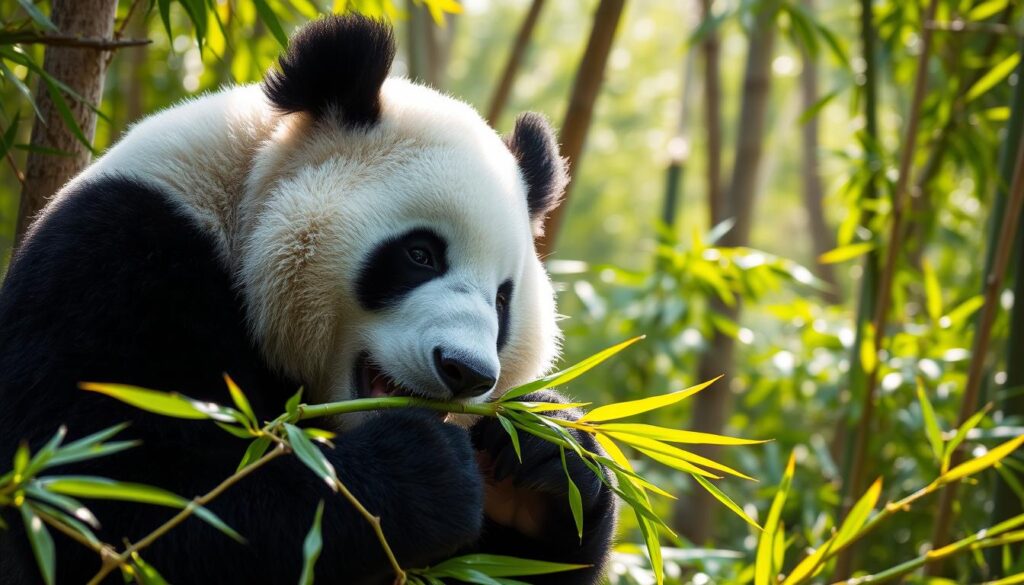
Giant pandas rely almost entirely on bamboo for food, making up to 99% of their diet. This makes them very sensitive to changes in their bamboo habitats. To protect pandas, it’s essential to keep their bamboo forests healthy and intact.
Importance of Bamboo Habitat Preservation
Keeping bamboo ecosystems healthy is key for wild giant pandas. They have evolved to live in these environments, needing different bamboo species for food. Threats like deforestation and habitat loss are big challenges for panda conservation.
Dietary Management in Captive Pandas
In zoos, pandas face diet challenges because it’s hard to match their natural bamboo diet. They can get sick, showing the need for careful diet planning. This might include adding supplements or using different bamboo types.
Creating new ways to grow bamboo, even in cold places, helps feed captive pandas. By studying their diet, we can improve their care in zoos. This helps keep pandas healthy and happy.
It’s vital to protect bamboo habitats and find ways to grow bamboo sustainably. By focusing on pandas‘ dietary needs, we can help them thrive in both the wild and zoos. This ensures the survival of this beloved species for generations to come.
Also Read : The Panda-Inspired Guide to Growing and Using Bamboo in Your Backyard
Conclusion
The panda’s bamboo-based diet is a special way they live in bamboo forest habitats. Even though they have a carnivore-like digestive system, pandas have evolved to get nutrients from protein-rich bamboo shoots and leaves. Knowing how they eat bamboo and how their gut microbiota works is key to helping them.
The giant panda is one of the most endangered mammals in the world. Keeping their diet healthy is vital for their survival. Research shows how important their gut microbiome is for breaking down bamboo nutrients.
We must keep the bamboo forests safe and manage the pandas’ dietary needs. It’s important to understand how their diet and gut microbiome affect their health. This knowledge helps us protect these amazing bamboo-eating bears for the future.
FAQs
Q: What do giant pandas eat in their natural habitat?
A: Giant pandas primarily eat bamboo, which serves as their staple food source. They consume different parts of the bamboo, including leaves and shoots, to meet their nutritional needs.
Q: How much bamboo do pandas eat daily?
A: Pandas can consume up to 40 pounds of bamboo each day to fulfill their dietary requirements. This high bamboo intake is necessary due to the low nutritional value of bamboo.
Q: Can pandas eat meat?
A: While pandas are classified as carnivores, they have adapted to a herbivorous diet and rarely eat meat. Their digestive system of pandas is optimized for processing bamboo rather than meat.
Q: Why do pandas have a unique diet?
A: Pandas have a unique diet because they have evolved to depend primarily on bamboo as their food source over millions of years. This adaptation has shaped their feeding behavior and nutritional needs.
Q: What is the nutritional value of bamboo for pandas?
A: Bamboo provides essential nutrients for pandas, including carbohydrates, fiber, and some proteins, but it lacks sufficient fats and proteins found in other food sources.
Q: How do panda habitats influence their bamboo intake?
A: Panda habitats are crucial for their bamboo intake, as they must have access to vast areas of bamboo forests to meet their dietary needs and to ensure the health of giant pandas.
Q: How do conservation and research centers support the panda diet?
A: Conservation and research centers provide captive giant pandas with a carefully curated diet that includes bamboo, ensuring that they receive the nutrients necessary for their health and well-being.
Q: What are the challenges faced by pandas in the wild regarding their diet?
A: In the wild, pandas face challenges like habitat loss and climate change, which can affect the availability of bamboo. This can hinder their ability to survive, as they rely heavily on this food source.
Q: How do captive giant pandas differ in their dietary needs compared to wild pandas?
A: Captive giant pandas may require different dietary management to ensure optimal health. They often receive a more varied diet that includes supplements to meet their nutritional needs, unlike wild pandas who rely solely on bamboo.
Q: What role does bamboo play in the overall ecosystem for pandas?
A: Bamboo plays a vital role in the ecosystem for pandas as it not only serves as their primary food source but also provides habitat and shelter. The health of bamboo forests is crucial for the survival of giant pandas.

